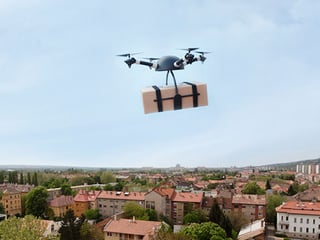Three predictions for retail drone delivery
The era of drone delivery in retail is finally arriving, but what will it actually entail?
In recent weeks, both Walgreens and CVS have launched historic pilots of “store to door” on-demand drone delivery. Meanwhile, industry leaders like Amazon and Walmart are actively developing drone programs of their own.
The “dawn of the drone” is here, but how drone delivery will ultimately unfold in retail is anyone’s guess. Here are three of mine.
Regulators, saddle up
The image of skies clouded with a constant stream of buzzing drones making deliveries day and night is like something out of a dystopian science fiction novel. Fortunately, science fiction is where that scenario will stay.
Commercial drone flights are heavily regulated by the FAA. Even the broadest certification, which allows carriers to fly as many drones supported by as many operators as necessary to meet customer demand, still requires authorization for each individual delivery operation. The FAA is unlikely to grant delivery authorizations to the point drones are blocking the sun.
In addition, drones are not the only autonomous delivery vehicle coming of age in retail. There has been far more activity in piloting ground-based deliveries via self-driving vehicles and robots, which will undoubtedly account for much of the driverless delivery traffic that appears to be heading our way.
Think small
Drone delivery is complex. Drones must either land and take off in a very precise customer delivery zone (which could be as small as a front stoop) or hover while a package is lowered via winch or simply dropped. This will restrict where drone deliveries occur geographically. CVS has already said it is eyeing drone-based delivery of prescription medication as a useful service for rural areas where customers may not have convenient access to the nearest store.
This complexity, combined with the size dimensions of drones, will also consign drone deliveries to smaller items. Drug stores, convenience stores and fast-food restaurants will be much more likely users of drones than consumer electronics or furniture chains.
Higher standards
Right now, there is a dizzying array of drones available from a variety of manufacturers. Amazon is designing its own Prime Air drone models, while companies including Google subsidiary Wing Aviation and UPS partner/drone systems developer Matternet offer their own proprietary aircraft.
Currently, there is little to no uniformity in drone design. The Wing Aviation drone in the Walgreens pilot resembles a grown-up version of a balsa wood flyer, while Amazon’s Prime Air prototype vaguely conjures the Imperial TIE fighters from “Star Wars” (note - I grew up playing with balsa wood flyers and “Star Wars” toys).
Inevitably, retailers will figure out what shapes and sizes best suit drone deliveries, and industry or even governmental standards bodies will likely arise. Whatever the future of drone delivery ultimately looks like, its appearance will have uniformity.












